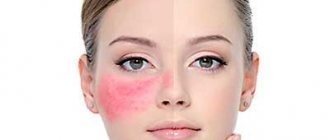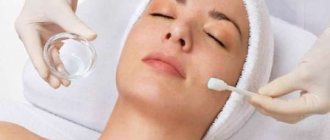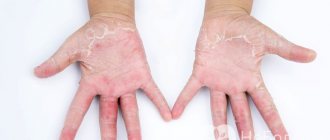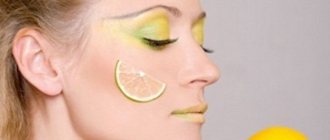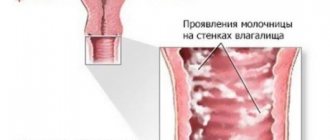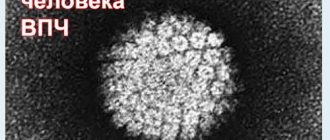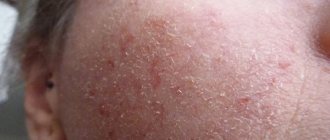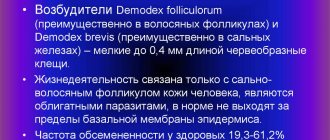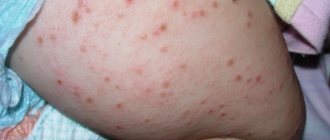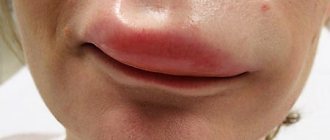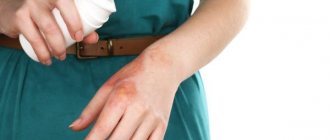Rosacea (rosacea) is a chronic skin disease of a non-infectious nature, which is characterized by severe redness of the face, the appearance of ulcers and vascular tubercles. In the final stages, the disease leads to noticeable changes in the patient’s appearance: the skin on the forehead, nose, cheekbones, chin, and cheeks thickens. Symptoms are perceived as a significant cosmetic defect, which is quite problematic to disguise. That is why the disease must be treated as soon as possible. In some cases, due to rosacea, patients begin to experience vision problems, as the disease is accompanied by eye damage.
What is rosacea
The exact cause of this disease has not been fully established.
Chronic, recurrent dermatosis of the epidermis, which is characterized by stages of polyetiological nature with possible angioneurosis of the venous system, is commonly called rosacea.
To put it simply, this disease manifests itself in the form of persistent, itchy redness on the skin with compactions in the form of nodules that unite into single formations. They can become covered with scales, sebum, and ulcers.
The exact cause of this disease has not been fully established. Doctors identify several possible factors that can provoke the development of this pathology.
Prevention
After eliminating the symptoms, you need to maintain the general condition of the body at a high level, avoid hypothermia, etc. If you adhere to the following recommendations, you can avoid relapses after therapy:
- reduce spicy, fried and salty foods in your diet;
- If possible, avoid coffee and alcoholic drinks;
- remove low-quality products from the diet (mayonnaise, ketchup);
- avoid exposure to sunlight, hypothermia;
- increase immunity;
- take tests for hormone levels and use medicinal products to maintain hormonal levels at normal levels.
Read about using a carrot mask to eliminate skin problems here.
Possible causes of rosacea
For a long time, the causative agent of this disease was considered to be a subcutaneous mite - demodex. However, based on numerous scientific experiments and laboratory studies, its complete non-involvement in the occurrence of the disease, as well as relapses (repeated appearance of symptoms), was established.
Possible causes of rosacea are currently considered to be exogenous and endogenous factors.
Exogenous factors include: alcoholic drinks, smoking, heat/cold, ultraviolet radiation, air dust. In the same category are hot, spicy, smoked, fried and fatty foods, hot drinks, and frequent stressful situations.
Endogenous factors include diseases of the endocrine system, psychovegetative diseases, disorders of the kidneys and brain, malfunctions of the immune system, hereditary factors, infectious diseases of the epidermis and gastrointestinal tract, including the presence of the bacterium Helicobacter pylori (which causes gastritis), the influence of mediator substances, vasoactive peptides , hormonal ointments and tablets.
Women aged 40 to 65 are at risk.
Lethal arsenal of doctors
The goal of treating rosacea is to strengthen the walls of the smallest blood vessels, but with the use of creams and other remedies, the symptoms of the disease disappear, but the problem does not disappear - the disease is simply masked. To completely relieve the patient of suffering once and for all, several modern methods are used:
- Electrocoagulation. This procedure involves cauterizing stars (bursted blood vessels). The method has its advantages and disadvantages. The main advantage is the low cost of the procedure and the reliability of the result. The downside is the formation of a skin crust at the treatment site, which does not subside for a couple of months. Plus, a pale white area will probably form at the cauterization site.
- Correction using laser. Used only in advanced cases. The method helps to completely get rid of skin defects. The advantage of the technique is that it affects a large area of skin, that is, several points of different sizes can be treated in one session. The disadvantage is the possibility of a side effect in the form of a burn or scar.
- Phototherapy. Allows you to remove burst vessels through the use of light pulses. An undeniable advantage is the absence of side effects. Almost no complications were identified during the procedure. The downside that will stop many patients is the cost of the procedure. It is in the range of 4500-6000 rubles.
- Ozone therapy. The essence of the procedure is that the patient is given an injection of an ozone-oxygen mixture. The mixture has a beneficial effect on the condition of the skin, strengthens damaged blood vessels, and gives the skin elasticity. Unfortunately, this method is only effective for small capillary stars.
There are many ways to quickly and painlessly get rid of facial skin problems, but the final treatment option can only be chosen by a doctor based on medical indications and anamnesis analysis.
In complex therapy, massage, vitamins and microelements are prescribed.
Symptoms and stages of the disease
The main signs of rosacea are persistent redness, itching, the formation of pink acne nodules, as well as pustular infiltrates.
There are 3 stages of the disease with the following characteristic signs of this process:
- The erythematous-telangiectatic stage is expressed by moderate redness, periodically localized in the center of the face. As the disease progresses, the redness becomes persistent and more extensive (can cover the entire face and neck), and the nodules become denser. In this case, a person experiences a feeling of itching, burning, tingling in the affected areas of the skin, which over time acquire a bluish tint.
- The papulopustular stage is characterized by the appearance of red papules in the cheeks, nose, chin, forehead and nasolabial folds, the size of which can reach 5 millimeters. Their structure is dense, with thin scales on the surface. They are localized in isolation or grouped without merging with other foci. This stage is accompanied by the appearance of infiltrates and swelling of the skin.
- The pustular-nodular stage is manifested in the appearance of persistent individual redness with many new foci on the surface of the skin, as well as plaques, edematous nodules and papules, merging into single, extensive conglomerates. Hyperplasia of the sebaceous glands, the appearance of connective tissue compactions, and cicatricial deformities lead to an increase in areas of skin damage. Against this background, disturbances occur in the blood and lymph flow, and puffiness of the face appears. The growth of tumor-like formations disfigures the face, and a severe form of the disease begins to develop - rhinophyma.
About half of patients experience eye damage, accompanied by redness, dryness, lacrimation, pain and a sensation of the presence of a foreign body.
Possible complications
Lack of timely treatment can lead to worsening of the dermatological disease and the development of the following complications:
- the addition of a bacterial infection, the occurrence of inflammation of the deeper tissues of the dermis, the appearance of abscesses;
- scars and scars that form after the removal of papules;
- a cosmetic and aesthetic defect, expressed in redness of large areas of facial skin, which outwardly resemble one continuous birthmark;
- blurred vision caused by the spread of rosacea to the mucous membrane of the eyes;
- formation of sebaceous gland cysts that require removal through surgery.
The causes of rosacea on the face in women of all age groups are associated with many factors, which can be associated with both the negative influence of the environment and the body’s negative reaction to internal stimuli (food allergies, infections, weakened immunity, endocrine disorders).
This disease is not dangerous to life and health, but it significantly reduces a woman’s quality of life and creates psychological discomfort.
Treatment methods for rosacea
Considering the multiple clinical manifestations of this disease, as well as the lack of a unified concept of the occurrence of this pathology, a dermatologist, as a rule, uses various treatment methods.
Treatment is offered in a comprehensive manner, involving the prescription of drugs for internal and external use, as well as the use of a variety of hardware and physiotherapeutic techniques. The use of local drugs that have a vasoconstrictor effect will also be recommended.
Medications include: compresses with a 2% solution of boric acid, resorcinol, which effectively eliminate the feeling of itching and burning, drugs based on tetracycline, antiparasitics, nitromidazole groups, antihistamines, synthetic retinoids, as well as antibiotics. Ointments based on sulfur have a good effect.
For oily skin with severe seborrhea, the use of lotions and gels that have anti-inflammatory, sebum control, cleansing, deep exfoliating, opening pores and skin disinfecting effects is indicated.
Alcohol-containing and hormonal products are prohibited, as well as visiting a solarium, bathhouse, or sauna!
Physiotherapeutic and hardware techniques include:
- cryotherapy, performed by contacting damaged areas of the skin with liquid nitrogen cooled to critically low temperatures. This procedure is performed every other day or every day (at least 10 sessions are required). It can be prescribed as a separate treatment method, as well as as part of a complex treatment for the purpose of deep exfoliation of the affected skin layers;
- rotational massage performed at the first stage of the disease to eliminate swelling and accelerate lymphatic drainage 2 times a day for several minutes with circular stroking movements;
- electrocoagulation (another name is cauterization), manifested in the direct effect of electrodes on lesions of the epidermis, leading to the destruction of red tumors. You will need to undergo from 20 to 100 such procedures;
- laser irradiation, which provides long-term remission and high efficiency in treatment due to the destruction of damaged vessels located close to the surface of the epidermis with a long-wave laser beam that causes a thermal effect and does not affect adjacent tissues. This procedure must be carried out every other day for 25 minutes for 6 sessions.
It is important to determine the diagnosis
If your symptoms suggest that you may have rosacea, consult a dermatologist. He will examine you, take tissue samples for testing and tell you exactly whether the diagnosis is confirmed or not and what treatment is best for you to undergo. Most often, a specialist prescribes both medications and the use of folk remedies. They will help you make your skin healthy, clean, and remove minor cosmetic defects.
There is a high probability that rosacea will not affect children or young people, but middle-aged and elderly citizens. The disease is often activated in those who suffer from diabetes, have impaired immunity or in the endocrine system.
Treatment is most effective and there are fewer traces of inflammation if you start treatment right away and do not let inflammatory processes take their course. Treatment should be carried out comprehensively using medications and procedures aimed directly at relieving inflammation on the skin.
Surgical treatment methods
The session is carried out under local anesthetics using devices
When the disease progresses to the stage of rhinophyma, in most cases, surgical intervention is prescribed, which consists of cutting out pathological tissues that have grown to large sizes.
Mechanical skin resurfacing and dermabrasion are also considered surgical techniques. They help remove the surface layer of the epidermis along with the upper layer of the dermis itself. The session is carried out under local anesthetics using devices equipped with a special surgical cutter.
After these procedures, maintenance therapy with special medications is prescribed to avoid repeated relapses.
Early diagnosis and timely treatment in the initial stages of the disease can eliminate the aggravation of pathological processes of skin damage, which can lead to a complete restructuring of epidermal cells with degeneration of their structure.
Features of use
Rosex cream has a weak effect on blood flow. But when taking a drug with the active ingredient metronidazole, you should know the specifics of using the drug:
- Be careful if you have liver disease.
- People under 18 years of age should not take metronidazole with amoxicillin.
- Taking metronidazole causes urine to turn dark.
- Alcohol should not be taken during treatment with metronidazole. This can cause diarrhea, vomiting, headaches, abdominal pain and flushing.
When treating with Rozex cream, it is not recommended to use cosmetics in the form of powder, blush, or thick foundation. Dermatologists do not recommend using alcohol-containing products, such as lotions and nourishing creams, during therapy.
Traditional treatment methods
We would like to warn you that traditional treatment recipes require mandatory approval from your doctor, as well as a preliminary test for an allergic reaction. They will not completely cure you of this pathology, but they will significantly relieve inflammation and promote rapid healing of the skin.
- Wipe the affected areas of the skin at night with a five percent solution of propolis (sold in pharmacies), and in the morning remove the resulting thin film using antibacterial compounds, such as chlorhexidine. Propolis has shown high effectiveness in the treatment of rosacea. At the same time, it is recommended to take a decoction consisting of nettle leaves, young stems of burdock and horsetail, taken in equal proportions. Two tablespoons of this mixture are poured into ½ liter of water and boiled for 5 minutes, take 100 grams before meals.
- Cranberry juice has long been considered an effective remedy in the treatment of such pathology. Juice is obtained from fresh cranberry fruits, a cotton swab or gauze piece is moistened with it, applied to problem areas and left for 40 minutes. After this, you will need to rinse your face with cool boiled water, dry it and powder it a little. This procedure is performed once a day until the redness and number of nodules decrease, after which it will need to be performed every other day, then two, and so on until the symptoms completely disappear. If you experience discomfort such as a burning sensation, try diluting cranberry juice with water in a 1:1 ratio.
- Aloe juice, the leaves of which have been previously kept in a dark, cool place for 2 weeks, has a regenerating, anti-inflammatory, healing and skin-restoring effect. Take water and aloe juice in equal proportions and mix the composition thoroughly. A cotton pad or a piece of bandage is moistened in this solution, applied to the areas of skin affected by rosacea and left for 20 minutes. It will be necessary to conduct at least 20 such sessions.
- This pathology is also successfully treated with a decoction of linden and chamomile. To prepare it, take 1 tablespoon of these herbs, mixed 1:1, pour it with a glass of boiling water, close the lid tightly and leave until completely cooled. Lotions are made from this infusion (see point 3).
- A decoction of tansy, sage and string is prepared in the same way. The resulting infusion is used to make lotions.
- A large burdock leaf is washed under running water, holes are made in it for the eyes, mouth and nose, after which it is immediately applied to the face and held with hands for 20 minutes.
- Fresh elderberry leaves are washed, scalded with boiling water, allowed to cool slightly and applied to the face as a mask, kept for 20 minutes.
- Dry herbs of bedstraw, red clover, burdock and horse sorrel taken in equal proportions are poured with boiling water at the rate of 1 tablespoon of herbal mixture per glass of boiling water. The composition must cool, after which you will need to make compresses from it, keeping them on the skin for 20 minutes. This procedure will need to be performed daily for a month.
- Fresh cabbage juice is diluted with warm water in a 1:1 ratio. It is used to make lotions on the skin of the face using a gauze cut. Keep these masks on your face for at least 20 minutes. You will need to do 20 sessions, performed every other day.
- Make dandelion juice (ground the flowers, leaves and roots in a meat grinder or blender), add a little honey to remove the bitterness and the juice of ½ lemon. Drink this composition for 2 weeks, a tablespoon 4 times a day, 30 minutes before meals.
- A decoction of mint and calendula taken orally showed good results. To prepare it, take a tablespoon of mint herbs and calendula flowers, pour them with 1 liter of cold water, boil for 10 minutes, and leave for 20. Strain the resulting decoction and drink a glass twice a day half an hour before meals. You can add a little honey for taste. They drink it every day for a whole month, then take a break for a week and use it again for a month. Full course - 3 cycles.
- Linden baths are excellent for relieving skin inflammation due to rosacea. This is how they are done. Linden blossom (flowers) in the amount of ½ cup is poured into 2 liters of water, the mixture is brought to a boil and cooled to 15 degrees. Take a convenient wide container, pour this decoction into it and lower your face there for 5 seconds. Rest for 5 seconds and repeat everything again. The duration of the procedure is 10 minutes (morning and evening).
- Chamomile ice stops the progression of rosacea. First, prepare a decoction consisting of 2 tablespoons of chamomile, boiled over low heat for 10 minutes in 0.5 liters of water. The cooled and strained broth is poured into molds and frozen. Pieces of such ice are used to wash the skin by massaging for 5 minutes every day. After such manipulation, the face is not wiped, but is waited for to dry on its own.
- Blue and green clay has a regenerating, strengthening, anti-inflammatory, vitamin, tonic effect, saturates cells with all the necessary microelements that restore health and elasticity to the skin. Take 2 tablespoons of clay powder, dilute it with purified water to a mushy state, apply it as a mask to the skin of the face, leave for 30 minutes and rinse with warm boiled water. This mask is done every 4 days, once a day, preferably in the evening.
How are pharmaceutical cosmetics different from regular ones?
Therapeutic cosmetics for the face in pharmacies are represented by a huge variety of different brands. The main difference between such products is that they are able to solve severe skin problems, as they can penetrate into the deep layers of the skin. Conventional cosmetics do not penetrate beyond the epidermis, so the results from its use are much less pronounced than from using pharmaceutical ones.
Pharmacy cosmetics are subject to careful control. Before going on sale, it undergoes a large number of studies and receives certificates confirming its high quality and safety. To obtain a certificate, in addition to laboratory and scientific research, it is necessary to undergo clinical trials.
Manufacturers of pharmaceutical cosmetics are required to fully list the entire composition on the packaging, so there cannot be any hidden components. For ordinary cosmetics, such strict rules do not exist, so some substances may be hidden from the consumer. The composition of pharmacy products differs significantly from products included in the “mass market” segment.
Therefore, people with oily or combination skin types are recommended to use only pharmacy products, since regular ones can provoke the formation of acne.
As part of pharmacy cosmetics, the main emphasis is on:
- natural extracts;
- antioxidants;
- thermal water.
They carefully take care of the skin, strengthening its protective properties. Pharmacy cosmetics can also be represented by a class of selective products. Their main task is to eliminate imperfections that cannot be addressed by conventional products. These products contain powerful components that have healing and moisturizing properties.
Don't miss the most popular article in the section: Face fitness for facelift, rejuvenation, muscle tone. Master class from Elena Karkukli
